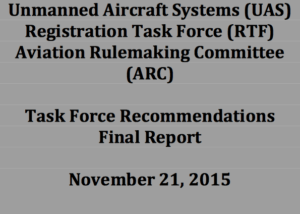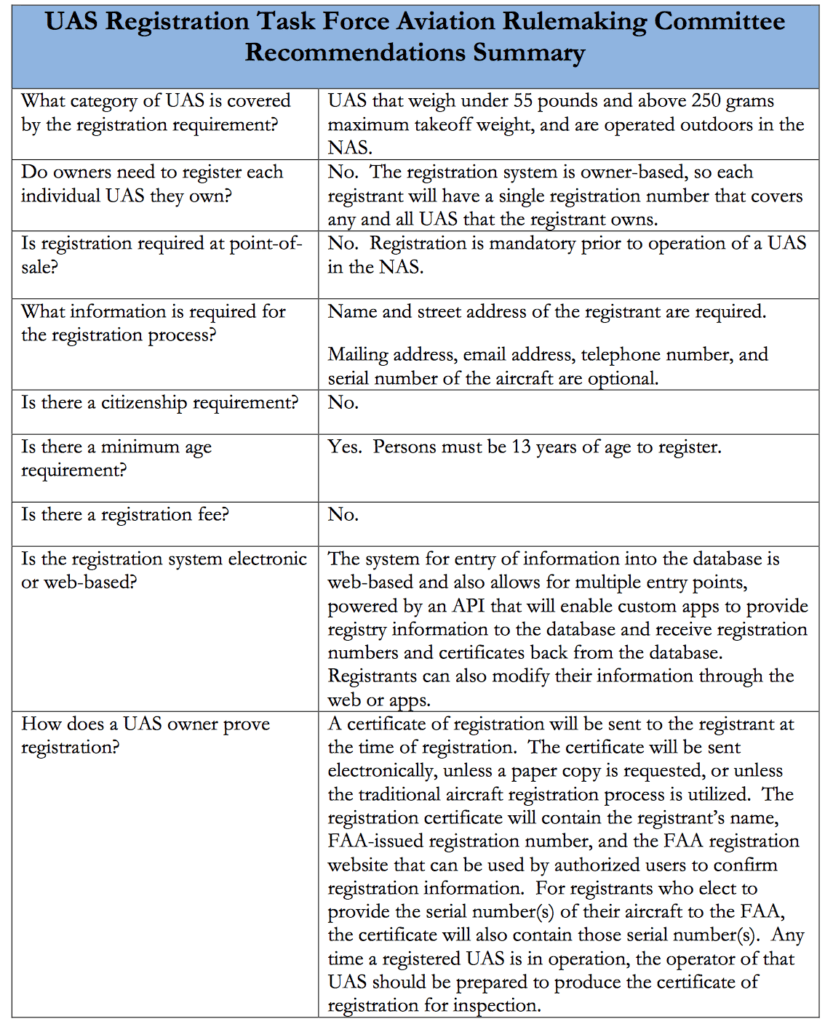 Over the weekend, the FAA released the Final Report summarizing the recommendations for registering unmanned aerial vehicles developed by the UAS Registration Task Force which was created last month to deliver some rules for regulating drones in our airspace before the busy holiday season.
Over the weekend, the FAA released the Final Report summarizing the recommendations for registering unmanned aerial vehicles developed by the UAS Registration Task Force which was created last month to deliver some rules for regulating drones in our airspace before the busy holiday season.
The report is rather short for a document of this magnitude (federal drone registration has been discussed for years, but no action was ever taken) but it answers some important questions and lays out an excellent ground work for holding drone operators accountable.
Before we take a look at the Task Force’s recommendations, it is important to make note of one crucial point from the document’s executive summary: “The Task Force agreed that it was outside the scope of the Task Force’s objective to debate or discuss the DOT Secretary’s decision to require registration of sUAS or the legal authority for the implementation of such a mandate.”
So, nothing in this document is legally binding. The FAA and DOT could throw the whole thing out if they wanted to, but that is unlikely to happen because the recommendations, while technologically challenging, are extremely reasonable.
First and foremost, the Task Force recommended a free, owner-based registration system that allows users to receive an electronic certificate of registration and personal universal registration number. The certificate and number should be attainable, for free, through a form online or via a mobile application and applicants would be required to provide the FAA with their name and address to obtain their registration.
Registrants would then be required to display their number on all their sUAS (drones).
The Task Force further recommended the system “be powered by an Application Program Interface (API) so multiple app clients could feed registration information into the database.”
In other words, with a widely available API, drone systems with custom mobile applications (DJI, Parrot etc.) could have users register in-app and send that information directly to the FAA.
Other important lines drawn by the Task Force are:
- Size requirements (less than 55 pounds but more than 250 grams).
- Operators are not required to report the make and model of their aircraft.
- There is no citizenship requirement for registration.
- Registration is required prior to takeoff, not at point of sale.
- Registration is required for individuals of 13 years or older and children under that age operate under a parent or guardian’s registration.
- There should be some sort of education component and acknowledgement, “With controls in place such that the registration process would be incomplete until the registrant has acknowledged receipt of this information.” Sort of like a Terms and Conditions for flying. The Task Force recommended using the existing Know Before You Fly program to fulfill this requirement.
This all seems reasonable, right?
The FAA wants to be able to find the owners of crashed drones and hold them accountable for damaged property or unlawful flying but the registration process should be free and easy.
You shouldn’t have to register toys that pose no danger to anyone, but it’s not unfair to allow the government some minimal oversight when it comes to this new technology.
Of course, as mentioned above, these are only recommendations. It is still up to the FAA to use this document as well as public comment to summit actual rules and regulations for governing UAS to the DOT.
No word yet on when that will be, but this latest development is a tremendous step in what has been a painfully drawn out process.
For a further summary of the Task Force’s findings, check out the table below.
Alan is serial entrepreneur, active angel investor, and a drone enthusiast. He co-founded DRONELIFE.com to address the emerging commercial market for drones and drone technology. Prior to DRONELIFE.com, Alan co-founded Where.com, ThinkingScreen Media, and Nurse.com. Recently, Alan has co-founded Crowditz.com, a leader in Equity Crowdfunding Data, Analytics, and Insights. Alan can be reached at alan(at)dronelife.com









The FAA registration process is simply to identify the operator/owner should the UAV be involved in a violation or worse yet a property damage or personal injury accident so the responsible party can be held accountable. If someone forces me to take evasive maneuvers in my aircraft because they are violating Federal Aviation Regulations I most certainly want the person held accountable. The problem is that non-pilots have no understanding of the NAS (national airspace system) and most certainly will fly where they shouldn’t and lives will be lost. The first airliner that is brought down from an errant UAV will quite possibly end the right to fly these fun aircraft for everyone. Education is key with any new technology.
The report itself brought forth the possibility of a registration fee of $0.001 which comes out to 1/100th of a cent, if implemented. Registering an N-number for an aircraft or commercially operated Section 333 UAS (Drone) comes to a total of about $15.00. Given the cost of Commercial Drone Systems and actual inhabited Aircraft, those amounts are a fraction of the overall acquisition cost. Now given the cost of the actual administration of the National Airspace System, these are tiny amounts. Compare that to Europe, where you are charged every time you key a mike on the radio, are charged landing fees, etc. I don’t see a Tax Grab, but I do see some effort to ensure that people operate responsible, learn the rules, and most importantly, learn how to respect those same rules.
Happy Thanksgiving Everyone.
Aloha,
William S. Cobb
This won’t be free any more than it won’t be over reaching by the FAA. The government is meddling for a reason and that is simply money. This registration is simply a hidden tax. Next they will want back ground checks, pschological assessments , ground school , licenses , flight plans and anything else the government can make money off of. TAX GRAB nothing more, nothing less.